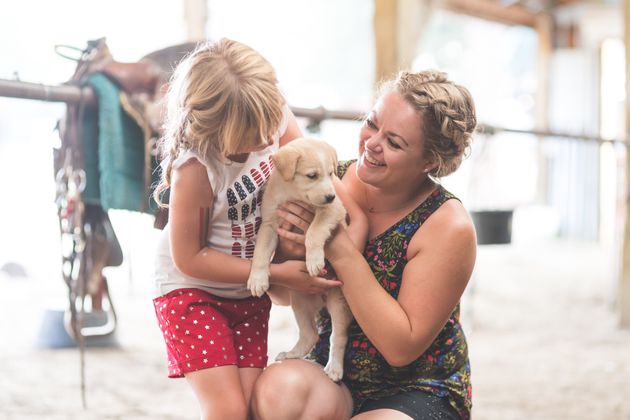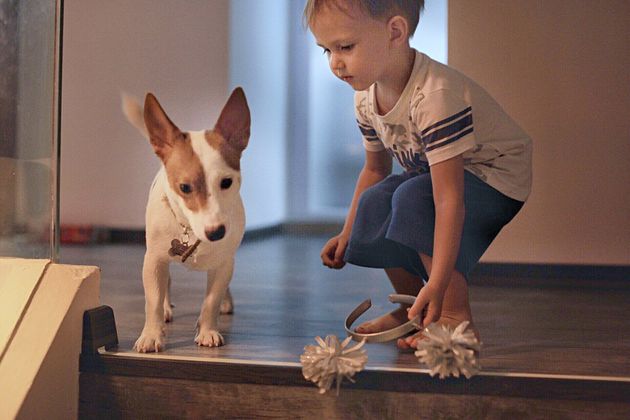Children need to be taught how to stay safe around dogs to reduce the risk of avoidable injuries, MPs have said.
The cross-party Commons Environment Committee said they want animal behavioural experts and charities to come up with a “canine childhood education plan” for schools and parents.
They cited evidence that children under nine were statistically more likely than any other age group to end up in hospital after being bitten by a dog. Despite this, information given to new parents doesn’t include specific advice about keeping their family safe around pets.
[Read More: MPs Call For Review Of Banned Dog Breeds]
The committee urged minsters to support a study into what the most effective education measures on safety around dogs would look like.

With no current programme in place to teach kids about dogs, how can parents bridge the gap?
We spoke to experts at charities to get their guidance on educating kids to be safe around pups, whether it’s their own or one they meet out in the park.
#1 Teach Kids To Approach Dogs Slowly And Quietly.
Kids are often bouncing off the walls with energy, but try to teach them (from a young age) to be calm and quiet when approaching dogs. That means no loud noises or sudden movements. “This especially is true when meeting a dog out and about,” Hollie Sevenoaks, head of education at Dogs Trust told HuffPost UK. “Always approach them slowly, calmly and quietly. Don’t walk directly towards their head or face, and always greet a dog from the side giving them as much space as possible.”
#2 Educate Your Kids About Sleeping Dogs.
Dogs spend a large part of their day sleeping and while little ones may be desperate to play with them, it’s important they can nod off without being disturbed. Battersea Dogs’ and Cats’ Home advise parents to remind kids that dogs – just like us – may be a bit grumpy when they wake up, so to never approach or try to wake a dog who is sleeping.
“Dogs should have their own place to sleep i.e. in a dog bed,” they added. “This bed should not be in your bedroom.”
The same advice can be applied when dogs are eating.
#3 Encourage Your Child To Interact With The Dog’s Owner.
A good lesson to teach your kids is to always ask a dog’s owner whether it’s okay to say hello, and ask permission before you touch them. “Sometimes the owner will say yes, when their dog is saying no,” Sevenoaks advised. “As an adult, you should take a look at the dog’s body language. If they don’t acknowledge you or they move away, they probably don’t want to interact with you and your child. If that happens, let the dog have their space.”

If the owner says “yes”, you should remind your child of the “slow and quiet” rule (above). “Teach your child to stand still at the side of the dog with arms by your side, palms forward, and let the dog come to them,” Sevenoaks added. “Don’t be tempted to reach out or lean forward to try and touch them, as it could be a bit too much of a surprise.”
#4 No Kissing Or Hugging.
No matter how much your child is in love with their pup, kissing or putting their face right in the dog’s face isn’t advised, even with the family pet. “Dogs can usually feel smothered if this happens,” a spokesperson at Battersea said.
Work with your child to come up with other ways they can show their dog affection, such as a gentle stroke.
#5 Set Rules Around Playtime.
Blue Cross advise parents to always supervise kids, especially toddlers, during doggy playtime. Children should be taught that all games should be kept relatively calm, and stopped if the dog gets overexcited.
“Rough and tumble games are not good as they teach the dog to be rough,” advised Battersea. “Games like fetch and retrieve are much safer. Remember play-biting may not hurt much when your dog is a puppy, but it will hurt when he is older.”
Teach your kids to play other games with their dogs including shake a paw, play dead, or roll over.
#6 Never Ever Leave A Child And Dog Unattended.
The RSPCA’s number one golden rule about kids and dogs is to never leave a child unattended with a dog, even if it is their own.
For more information:
Dogs Trust runs an extensive education programme Be Dog Smart, which is designed to teach children, and anyone who has responsibility for children to be safe around dogs. Find out more here.
RSPCA has advice and information on their website. Read their full guide on children and dogs here.